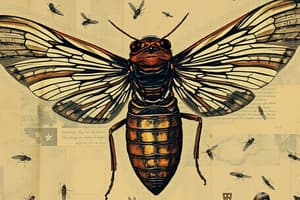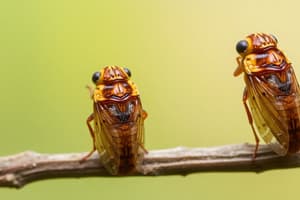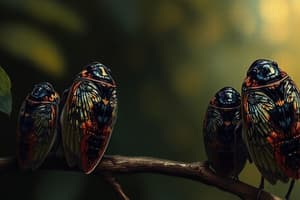Podcast
Questions and Answers
What is the main reason cicadas emerge every 13 or 17 years?
What is the main reason cicadas emerge every 13 or 17 years?
- To avoid predators that have shorter lifespans. (correct)
- To maximize reproduction in urban areas.
- To synchronize with other insect life cycles.
- To avoid climate changes that affect their habitat.
How often do the two broods of cicadas overlap in the same state?
How often do the two broods of cicadas overlap in the same state?
- In Maryland and Alabama.
- Only in Illinois and Iowa. (correct)
- In all states from Oklahoma to Maryland.
- In all US states where they emerge.
What is the peak period for the cicada population expected to occur?
What is the peak period for the cicada population expected to occur?
- Mid-April to late April.
- Late June to early July.
- Throughout the entire summer.
- Starting mid-May for two-to-three weeks. (correct)
Why are young trees more susceptible to damages from cicadas than mature trees?
Why are young trees more susceptible to damages from cicadas than mature trees?
What is the decibel level of the male cicadas' mating call?
What is the decibel level of the male cicadas' mating call?
When do cicada eggs typically hatch after being laid?
When do cicada eggs typically hatch after being laid?
What is a unique characteristic of the cicada's lifecycle regarding its lifespan underground?
What is a unique characteristic of the cicada's lifecycle regarding its lifespan underground?
What can experts suggest to protect young trees from cicadas?
What can experts suggest to protect young trees from cicadas?
Flashcards
Periodical Cicadas
Periodical Cicadas
A group of insects that emerge from the ground every 13 or 17 years to reproduce and die shortly after.
Cicadas as a Food Source
Cicadas as a Food Source
These insects are a source of food for a variety of animals, and their bodies contribute nitrogen to help trees grow.
Prime Number Survival Strategy
Prime Number Survival Strategy
Cicadas have a unique evolutionary strategy to avoid predators by emerging on a prime number cycle.
Cicada Drone
Cicada Drone
Signup and view all the flashcards
Cicada Egg Laying
Cicada Egg Laying
Signup and view all the flashcards
Cicada Peak Emergence
Cicada Peak Emergence
Signup and view all the flashcards
Cicada Life Cycle
Cicada Life Cycle
Signup and view all the flashcards
Double Brood Emergence
Double Brood Emergence
Signup and view all the flashcards
Study Notes
Cicada Brood Emergence
- Sixteen US states are experiencing a rare simultaneous emergence of two cicada broods: Brood XIX (13-year cycle) and Brood XIII (17-year cycle).
- This event hasn't happened in 221 years, and the next occurrence will be in 2245.
- Emergence peak is expected mid-May, lasting two to three weeks.
- Overlap is expected in Illinois and Iowa, with close proximity in many other states.
Cicada Lifecycle and Behavior
- Cicadas spend most of their lives underground, feeding on tree roots.
- They emerge every 13 or 17 years to reproduce and die soon after.
- Their bodies provide a food source for animals and nitrogen for trees.
- The emergence cycles are prime numbers (13 and 17) to avoid predators with 2, 4, or 8-year cycles.
- Females lay eggs in young twigs and vines, causing damage but not to mature trees.
- Eggs hatch in 4–6 weeks, and the new generation burrows into the ground to repeat the cycle.
Cicada Characteristics and Impacts
- Cicadas are harmless to humans.
- Swarms can be a nuisance due to their numbers and the noise of males (up to 90 decibels).
- Males attract females with high-pitched drones and the insects can severely damage young fruit or nursery trees by laying eggs.
- Covering young trees with nets is advised to protect them.
Personal Observations (Note: This section presents an opinion, not fact)
- The author found cicadas harmless and even fun to watch.
- They observed that cicadas do not bite.
- The author dared to put cicadas on their head and survived.
- Some people think they aren't cute due to their behavior, but this is incorrect.
Studying That Suits You
Use AI to generate personalized quizzes and flashcards to suit your learning preferences.





